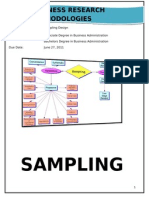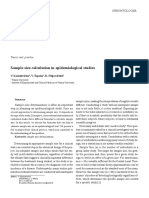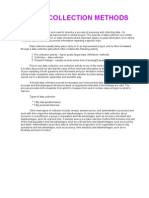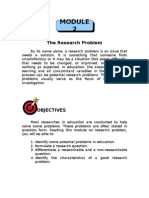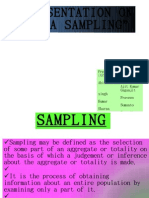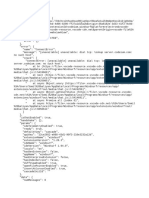Presentation On Sampling: Group Members
Uploaded by
Shahid Ali DurraniPresentation On Sampling: Group Members
Uploaded by
Shahid Ali DurraniPresentation on Sampling
Group members
1. Farman Ullah Khan
2. Syed Tauseef Ali
3. Tahir Aziz
MS finance 1
st
semester NUML
university
Agenda of the presentation
Sampling definition
Objective of Sampling
Definition of Sample
Examples of Sample
What is Population
Examples of Population
Reasons for Sampling
Difference between Sample and population
Different terminologies used in sampling
Element
Population
Target Population
Sample frame
Sample frame error
Sampling unit
Subject
Observation unit
Unit of Analysis
Statistics and Parameters
Standard symbols
N = Population size
n= Sample size
= Population mean
x= Sample mean
= Population standard Deviation
S= Sample standard Deviation
Types of Sampling
Probability Sampling or Random Sampling
Non Probability Sampling or non Random or Judgment sampling
Probability Sampling with Example
Non Probability Sampling
Biased Sample
Types of Probability sampling
1. Simple random sampling
2. Systematic sampling
3. Stratified sampling
4. Cluster sampling
Types of non Probability
Convenience sampling
Purposive sampling
Quota sampling
Snow Ball sampling
Sequential Sampling
Theoretical Sampling
Sampling Definition
The procedure by which we select or draw
sample from a given population is called
Sampling.
Objective :
The aim of Sampling is to get maximum
information about the population from which
sample is drawn.
Definition of Sample
Sample is the subset or portion of population.
Or
A small group of people studied to collect
information to draw conclusion about the
larger group
Example:
1. 10 gram sugar is sample and 5000 sugar bags is population
2. 40 patient out 145 to be surveyed to judge their level of
satisfaction with treatment received
Population
The population is the set of entities under study
The entire group of people, event or things of
interest that the researcher wishes to investigate.
e.g.
If you want to know the average height of the
residents of Punjab, that is your population, ie,
the population of Punjab, Pakistan.
If company CEO want to know the kinds of
marketing strategies adopted by firms in
Islamabad, then all firm situated there will be
population
Different terminologies used in
sampling
Element:
An element is a single member of population
For example:
Approval of 1000 machinery parts after inspecting few, so
there will be ,1000 element in this population
Sample Unit:
The element or set of element that is available for selection in
some stage of the sampling process.
e.g.
House hold ,individual in house hold like children under 5 year
,adult men
Subject
A subject is a single member of the sample.
e.g.
If sample of 50 machines out of total 500 is to be
inspected then every one of 50 machine is a
subject.
Reason for Sampling
The reason of using sample rather collecting data
from the entire population are clear.
It is practically impossible to investigate several
elements in population .
It is also time consuming ,costly and other
recourses
e.g.
In testing the life of bulbs, if we were to burn every
single bulb produced, there would be none left to
sell.
Sampling Process
Sampling is the selection of sufficient number
of the right elements from the population, so
that a study of the sample and an
understanding of its properties or
characteristic make it possible for us to
generalize such properties or characteristic to
the population elements.
Major Steps in
Sampling
Define the population
Determine the sample frame
Determine the sampling design
Determine the appropriate sample size
Execute the sampling process.
Define the population
Sampling begin with precisely defining the target
population.
The target population population must be define
in terms of elements ,geographical boundaries
and time
e.g.
The advertising agency interested in reading habits
of elderly people, the target population might be
the Pakistan population aged 50 and over
Determine the sample frame
Sample frame is a (Physical) representation of all the
elements in the population from which the sample is drawn
Sample frame is the actual set of units from which a sample
has been drawn
e.g.
Payroll of an organization if its member are to be studied.
a survey aimed at establishing the number of potential
customers for a new service in the population of New York
City. The research team has drawn 1000 numbers at
random from a telephone directory for the city, made 200
calls each day from Monday to Friday from 8am to 5pm and
asked some questions.
Example
In this example, population of interest is all inhabitants of
the city
the sampling frame includes only those New Your City
dwellers who satisfy all the following conditions:
has a telephone;
the telephone number is included in the directory;
likely to be at home from 8am to 5pm from Monday to
Friday;
not a person who refuses to answer all telephone
surveys.
Determine the sampling design
There are two types Sampling Design
Probability Sampling
Non probability Sampling
Probability Sampling
In probability sampling elements of population have some
known, non zero chance or probability of being selected as
sample subject.
Non probability Sampling
In non probability sampling element do not have a known
or predetermined chance of being selected as subject.
Determine the appropriate sample size
There are some factor affecting decision on
sample size i.e.
The research objective
The extent of precision desired
The acceptable risk in predicting that level of
precision.
The cost and time constraint
Types of sampling
Two types of Sampling
1. Probability Sampling
2. Non- Probability Sampling
Probability Sampling
It is also called Random Sampling, A
probability sampling scheme is one in which
every unit in the population has a chance
(greater than zero) of being selected in the
sample, and this probability can be accurately
determined.
Probability Sampling
When every element in the population does
have the same probability of selection, this is
known as an 'equal probability of selection'
(EPS) design. Such designs are also referred to
as 'self-weighting' because all sampled units
are given the same weight.
Non-Probability Sampling
It is also called Non-Random Sampling
Any sampling method where some elements of
population have no chance of selection or It is a
process in which the personal judgment
determines which units of the population are
selected for a sample.. It involves the selection
of elements based on assumptions regarding
the population of interest, which forms the
criteria for selection. Hence, because the
selection of elements is nonrandom.
Types of Probability Sampling
1. Simple Random Sampling
It is also known as unrestricted Random Sampling.
It is selected in such a way that each observation
of population has an equal chance of selection to
be included in a sample or the selection of each
observation have same chance to select from
population. e.g Lottery method.
A simple Random Sample is drawn by one of the
following devices ,
1. Tickets numbered from 1 to N for N units of the
population are placed in a basket and then units
of the sample are drawn one by one.
Simple Random Sampling
2. Random number tables have been constructed
and published to draw random samples.
3. Computers are used to draw random samples.
Two concepts of Simple Random Sampling
Sampling schemes may be without replacement
('WOR' - no element can be selected more than
once in the same sample) or with replacement
('WR' - an element may appear multiple times in
the one sample).
Example
For example, if we catch fish, measure them,
and immediately return them to the water
before continuing with the sample, this is a
WR design, because we might end up catching
and measuring the same fish more than once.
However, if we do not return the fish to the
water (e.g. if we eat the fish), this becomes a
WOR design.
Stratified Random Sampling
In stratified Sampling, the population is
divided into relatively homogeneous sub-
populations. These sub-populations are non
overlapping and together they comprise the
whole population. These sub-populations are
called Strata and the process is called
stratification. Simple Random Samples are
then drawn independently from each stratum
and combined into a single sample. The whole
procedure is known as stratified Random
Sampling.
Systematic Random Sampling
A Sampling technique in which the first unit
is selected with the help of random numbers
the remaining can be selected automatically
according to some pre-designed pattern is
known as Systematic Random Sampling.
Example;
A simple example would be to select every 10th
name from the telephone directory (an 'every
10th' sample, also referred to as 'sampling
with a skip of 10')
Cluster Sampling
In cluster Sampling the population is divided into
many sub-groups, each with only few elements ,
having heterogeneity
within sub-groups and homogeneity between
sub-groups. These sub- groups are called clusters
and the process is called clustering. Each cluster is
taken as a sampling unit of the population. A
random sample of these clusters are then drawn
,these procedure is called clustering sampling.eg
First we select group like ten teams and then we
choose three teams among them.
Biased Sample
It is a process in which all participants are not
equally balanced or objectively represented. It
is also known as Weighted Sample.
Non Probability Sampling
Definition of Non Probability Sampling
In Non probability sample designs, the elements in the population do
not have any probability attached to their being chosen as sample
subject.
Limitation of non probability sampling
Each element in the population has not an equal chance of being
selection in the sample.
The findings from the study of sample can not be generalized over
the population.
Subjects are selected as the researcher finds it more convenient
So, why non probability sampling?
It is used in the initial stage of your research mainly for
exploratory research
It helps to get hold of the topic or understand the research
topic by having some basic information
It is used to have some preliminary information
When you have limited time you use non probability sampling
When you are interested more in finding the solution to the
problem rather than the generalizability.
Types of Non Probability Sampling
1. Convenience Sampling
2. Purposive Sampling
a) Judgment Sampling or Expert opinion Sampling
b) Quota Sampling
3. Snow ball Sampling
4. Sequential Sampling
5. Theoretical Sampling
Convenience Sampling
Definition of convenience sampling
As its name implies convenience sampling refers to the
collection of information from members of the population who
are conveniently available to provide it.
Example 1: Ali from a Geo TV channel with a camera man and
a microphone in his hand asking about the a particular issue
Here Ali will interview any person that he finds and is willing
to be interviewed
Example 2:
Marketing team of Pepsi wants a research
about what the people prefer Pepsi or Coke
and their experience about Pepsi.
Here that marketing team will interview any
person nearby some superstores at their
convenience
Purposive sampling
Instead of collecting information from most readily or
conveniently available we prefer to obtain information from
those who meet some criteria or have some knowledge related
to our topic.
Here we set some criteria to chose a subject
Only those will be included in the sample who meets the
criteria
Purposive sampling has further two
types
1. Judgment sampling or expert opinion
sampling
2. Quota sampling
Judgment sampling or expert opinion sampling
Judgment sampling involves the choice of subjects
who are most advantageously placed or in the best
position to provide the information required.
Most of the times these people are at the top
possessions
Example:
If we are interested in the skills needed for a women
to rise to the top possession (the president, wise
president or executive)
Here in this example we will take a sample of only
those women who are at the top possessions
We are taking feed back from only those women
who are at the top level
There is a bias but we have no other choice
Less generalizable but good to solve the current
problem
Quota sampling
A second type of the purposive sampling
ensures that certain groups are properly
represented in the study through the
assignment of the quota.
Here the researcher first selects the groups
and then he provides the quota to each
group to ensure the representation of each
group in the sample
Example:
If we want to study the working habits of the
managers in corporation
Here there are many layers in the management
and different numbers of manager in different
levels
Many at lover level and less at the top
To provide them a fair chance of representation
we provide the quota to each level.
Snow ball sampling
Snow ball sampling (also called network,
chain referral or reputational sampling) is a
method for identifying and sampling cases in
the network. It is based on an analogy to a
snowball which begins small but becomes
larger as it is rolled on wet snow and it pick up
additional snow.
This method of sampling is used when we can
not find our subjects to conduct our study
Example:
If we are interested in some characteristic of
underworld criminals so first of all we have to
find a single criminal, we will get information
from him and will ask to give 4 names of his
friends like him, then we will contact those
four and from those four we will ask from each
to give four other names.
You might also like
- Stock Watson 3u Exercise Solutions Chapter 13 InstructorsNo ratings yetStock Watson 3u Exercise Solutions Chapter 13 Instructors15 pages
- National Ecotourism Strategy and Action Plan 2013-2022100% (3)National Ecotourism Strategy and Action Plan 2013-202285 pages
- VIP300 Protection Application Guide 2004 ENG PDF100% (1)VIP300 Protection Application Guide 2004 ENG PDF24 pages
- Sampling: Business Research MethodologiesNo ratings yetSampling: Business Research Methodologies21 pages
- LESSON 1 Qualitative Research and Its TypesNo ratings yetLESSON 1 Qualitative Research and Its Types37 pages
- Scope and Limitation of The Study in Social Research: Research. Ibadan: Ibadan University Press. Pp. 105-114No ratings yetScope and Limitation of The Study in Social Research: Research. Ibadan: Ibadan University Press. Pp. 105-11411 pages
- How To Develop A Questionnaire For Research - 15 StepsNo ratings yetHow To Develop A Questionnaire For Research - 15 Steps11 pages
- Sampleing and Sampling Distribution2016No ratings yetSampleing and Sampling Distribution201636 pages
- Relationships Between Theory by RevisionworldNo ratings yetRelationships Between Theory by Revisionworld2 pages
- LECTURE 3 Characteristics, Strength and WeaknessesNo ratings yetLECTURE 3 Characteristics, Strength and Weaknesses3 pages
- IKM - Sample Size Calculation in Epid Study PDFNo ratings yetIKM - Sample Size Calculation in Epid Study PDF7 pages
- Family As Social Institution: A Conflict Perspective88% (8)Family As Social Institution: A Conflict Perspective19 pages
- Concept and Sources of Primary Data and SecondaryNo ratings yetConcept and Sources of Primary Data and Secondary47 pages
- Optimum Theory of Population: An Assignment OnNo ratings yetOptimum Theory of Population: An Assignment On10 pages
- Final Assessment For Introduction To Research Methods (RMCR3101)No ratings yetFinal Assessment For Introduction To Research Methods (RMCR3101)4 pages
- CHAPTER III Sampling and Sampling DistributionNo ratings yetCHAPTER III Sampling and Sampling Distribution51 pages
- RESEARCH POPULATION, SAMPLE SIZE & SAMPLING METHODS - Qualitative ResearchNo ratings yetRESEARCH POPULATION, SAMPLE SIZE & SAMPLING METHODS - Qualitative Research5 pages
- Topic 1 Nature & Characteristics of Research & Topic 2 Types of ResearchNo ratings yetTopic 1 Nature & Characteristics of Research & Topic 2 Types of Research57 pages
- Chapter 1 Eqt 271 (Part 1) : Basic StatisticsNo ratings yetChapter 1 Eqt 271 (Part 1) : Basic Statistics69 pages
- Doaa Article Presentation Media LiteracyNo ratings yetDoaa Article Presentation Media Literacy23 pages
- KAS - 2020 Prelims - Gs - 1 (Foresightkas)No ratings yetKAS - 2020 Prelims - Gs - 1 (Foresightkas)20 pages
- 7SA522 Data Sheet For Setting Calculation Data Description Name of The Line General System and Sub-Station Data Value UnitNo ratings yet7SA522 Data Sheet For Setting Calculation Data Description Name of The Line General System and Sub-Station Data Value Unit1 page
- Archer Avenue St. Patrick's Day Parade 2024No ratings yetArcher Avenue St. Patrick's Day Parade 20242 pages
- Example of A Dissertation Problem Statement100% (1)Example of A Dissertation Problem Statement8 pages
- Ratio and Proportion Worksheets 7th Grade Worksheet 1No ratings yetRatio and Proportion Worksheets 7th Grade Worksheet 18 pages
- Indian Economy Current Affairs for APPSC PrelimsNo ratings yetIndian Economy Current Affairs for APPSC Prelims99 pages
- Brochure of Chiang Rai City MunicipalityNo ratings yetBrochure of Chiang Rai City Municipality8 pages
- Method Statement For Application of GRP Lining Inside Water Tank100% (1)Method Statement For Application of GRP Lining Inside Water Tank5 pages
- Composite Beam Design Manual: AISC 360-16No ratings yetComposite Beam Design Manual: AISC 360-1698 pages
- Stock Watson 3u Exercise Solutions Chapter 13 InstructorsStock Watson 3u Exercise Solutions Chapter 13 Instructors
- National Ecotourism Strategy and Action Plan 2013-2022National Ecotourism Strategy and Action Plan 2013-2022
- Scope and Limitation of The Study in Social Research: Research. Ibadan: Ibadan University Press. Pp. 105-114Scope and Limitation of The Study in Social Research: Research. Ibadan: Ibadan University Press. Pp. 105-114
- How To Develop A Questionnaire For Research - 15 StepsHow To Develop A Questionnaire For Research - 15 Steps
- LECTURE 3 Characteristics, Strength and WeaknessesLECTURE 3 Characteristics, Strength and Weaknesses
- Family As Social Institution: A Conflict PerspectiveFamily As Social Institution: A Conflict Perspective
- Final Assessment For Introduction To Research Methods (RMCR3101)Final Assessment For Introduction To Research Methods (RMCR3101)
- RESEARCH POPULATION, SAMPLE SIZE & SAMPLING METHODS - Qualitative ResearchRESEARCH POPULATION, SAMPLE SIZE & SAMPLING METHODS - Qualitative Research
- Topic 1 Nature & Characteristics of Research & Topic 2 Types of ResearchTopic 1 Nature & Characteristics of Research & Topic 2 Types of Research
- 7SA522 Data Sheet For Setting Calculation Data Description Name of The Line General System and Sub-Station Data Value Unit7SA522 Data Sheet For Setting Calculation Data Description Name of The Line General System and Sub-Station Data Value Unit
- Ratio and Proportion Worksheets 7th Grade Worksheet 1Ratio and Proportion Worksheets 7th Grade Worksheet 1
- Method Statement For Application of GRP Lining Inside Water TankMethod Statement For Application of GRP Lining Inside Water Tank






